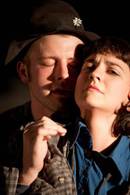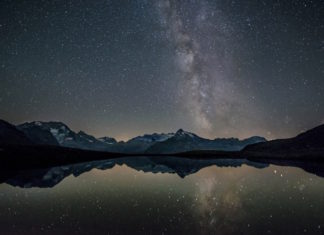 AndrasVisky’s I Killed My Mother, which is being given its New York premiere at La MaMa, under the direction of Karin Coonrod, is based upon real events, although how much is actual truth is not clear. This story of an orphan girl in Romania is told in a hard-edged, often impenetrable, and self-consciously poetic manner that doesn’t much concern itself with historic context. And while American audiences unfamiliar with the notorious conditions of the Ceausescu-era orphanages, where the play’s action begins, might be perplexed by its bewildering plot points, the piece is worth seeing for the intense performance of Melissa Lorraine Hawkins – for whom the work was written – as Bernadette, who is abandoned by her Gypsy mother.
AndrasVisky’s I Killed My Mother, which is being given its New York premiere at La MaMa, under the direction of Karin Coonrod, is based upon real events, although how much is actual truth is not clear. This story of an orphan girl in Romania is told in a hard-edged, often impenetrable, and self-consciously poetic manner that doesn’t much concern itself with historic context. And while American audiences unfamiliar with the notorious conditions of the Ceausescu-era orphanages, where the play’s action begins, might be perplexed by its bewildering plot points, the piece is worth seeing for the intense performance of Melissa Lorraine Hawkins – for whom the work was written – as Bernadette, who is abandoned by her Gypsy mother.
Visky clearly hasn’t written a docudrama. He seems to be trying to cast a wider net here, telling the tale of the universal orphan who comes to see all family ties as dehumanizing and corrupt. The fellow traveler and soulmate who helps Bernadette embrace such zealous independence is Chip (Andrew Hampton Livingston), whom she meets when both are extremely young, brutalized wards of the state.
There may even be a political allegory embedded here as well. “How come, if I’m free, I’m not happy?” Bernadette asks her friend during one moment of independence. She could be speaking for Eastern Europe itself, in the rocky wake of its decades-long dependence on Soviet control.
Any of this would be a legitimate approach to this story, but, as a theater piece, I Killed My Mother still needs to have a beating heart or two at its center. And too often, those hearts are obscured by thick metaphor. The production is also written and played at a fairly consistent climactic pitch, which is exhausting to watch, despite a relatively brief running time of less than 90 minutes.
Nonetheless, Hawkins is an actor of great vocal, emotional, and physical power who makes us care about her character. Livingston has an unfortunate tendency to overact, but he does have a few strong moments of chemistry with Hawkins, particularly in a rare tender passage in which a budding sexual awareness begins to blossom between the two.
He is also credited with composing the production’s original music, including a truly gorgeous ballad, for which he accompanies himself nicely on the ukulele, and which adds to the show’s atmosphere along with the deceptively simple but effective set and lighting design by Peter Ksander.














































